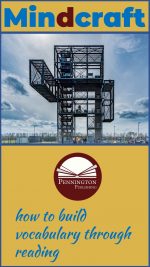Learn Vocabulary by Reading
Don’t read this article if you susceptible to thin-skin teacher disease. The typical vocabulary instruction in many classrooms includes passing out a “big words” list of 20 vocabulary terms on Monday and quizzing on this list on Friday. Starting to cringe? And now the buts start to formulate.
But half of those words on my list are from the literature selections this week.
But half of the words on my list are SAT®/ACT/academic language words.
But half of the words on my list are grade-level words that my students should know.
Other buts will focus on the learning process:
But I make them write out each word ten times.
But I make them create flashcards for each word.
But I use a crossword generator and have them do a crossword.
But I use a word jumble generator and have them do a word jumble.
But I have them underline the prefixes and suffixes and circle the roots.
If some of us are truly honest about why we really teach what and how we teach, we might confess, “That’s what and how I learned, and I turned out okay.”
The problem with the typical vocabulary instructional practice described above is not necessarily the selection of the words, themselves, nor the teaching approach. Indeed, the problem is one of effectiveness. According to research, “Rote memorization of words and definitions is the least effective instructional method resulting in little long-term effect (Kameenui, Dixon, Carine 1987).”
Also, the problem of teaching vocabulary as described above is one of efficiency. Let’s do the math.
If students remember all 20 words, each week for the entire school year, they will have mastered 600 words. Now, realistically, if teachers got students to remember half of those words by the end of the year, most would be pleased. That leaves 300 words mastered per school year.
But, the American lexicon is over 800,000 words, and the SAT® word bank is over 30,000 words. Students need to learn 3,000 new words per year just to make one grade level reading progress (Honig 1983). Learning 300 words per year is a very small drop in a very big bucket. So, not only is rote word memorization ineffective, it is also inefficient.
For thick-skinned teachers who have made it to this point in the article, there is hope. Students can master the 3,000 new words (or more) this year that reading experts agree are necessary to achieve one-year-growth in reading levels. How? Through independent reading.
If students read challenging text (with about 5%) unknown Tier 2 words, 30 minutes per day, four days per week, they will be exposed to 30,000 new words during the school year. Assuming that students will master the meanings of about 10% of those words through context clues, they will meet the 3,000 new words goal. But, we can do better. By teaching students to use context clues more effectively, we can confidently up that level of contextual mastery during independent reading to 15 or 20%.

Comprehensive Vocabulary
At this point, some some teachers might be tempted to follow former sixth grade teacher Donalyn Miller’s advice (The Book Whisperer) and allocate that 30 minutes of class time per day (or more) to independent reading. Perhaps vocabulary acquisition really is a natural process that is caught, not taught (Steven Krashen). Rather than teach, teachers should simply facilitate vocabulary acquisition by providing plenty of engaging books in their classrooms and time each day for sustained silent reading and rich literacy discussions.
Not so fast. I would encourage teachers not to give into that temptation. We still need to earn our paychecks. We can use homework for that independent reading time and save valuable class time for instruction. As a former principal of mine once said, “We’re not paying you the big teacher bucks to babysit students while they read.”
But let’s remember that most independent reading consists of Tier 1 words. We do need explicit vocabulary instruction to make a dent in those Tier 2 words which constitute the bulk of our academic language.
*****
For full-year vocabulary programs which include multiple meaning words (L.4.a.), Greek and Latin morphology with Morphology Walls (L.4.a.), figures of speech (L.5.a.), words with special relationships (L.5.b.), words with connotative meanings (L.5.c.), and academic language words (L.6.0), check out the assessment-based grades 4, 5, 6, 7, and 8 Comprehensive Vocabulary.
Get the Context Clue Strategies FREE Resource:
![]()
Get the Grades 4,5,6,7,8 Vocabulary Sequence of Instruction FREE Resource:
![]()
Get the Greek and Latin Morphology Walls FREE Resource:
![]()
Get the Diagnostic Academic Language Assessment FREE Resource:
![]()
Literacy Centers, Reading, Spelling/Vocabulary, Study Skills, Writing
